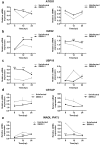Transcriptome meta-analysis reveals a dysregulation in extra cellular matrix and cell junction associated gene signatures during Dengue virus infection
- PMID: 27651116
- PMCID: PMC5030657
- DOI: 10.1038/srep33752
Transcriptome meta-analysis reveals a dysregulation in extra cellular matrix and cell junction associated gene signatures during Dengue virus infection
Abstract
Dengue Viruses (DENVs) cause one of the most prevalent arthropod-borne viral diseases affecting millions of people worldwide. Identification of genes involved in DENV pathogenesis would help in deciphering molecular mechanisms responsible for the disease progression. Here, we carried out a meta-analysis of publicly available gene expression data of dengue patients and further validated the meta-profile using in-vitro infection in THP-1 cells. Our findings reveal that DENV infection modulates expression of several genes and signalling pathways including interferons, detoxification of ROS and viral assembly. Interestingly, we have identified novel gene signatures comprising of INADL/PATJ and CRTAP (Cartilage Associated Protein), which were significantly down-regulated across all patient data sets as well as in DENV infected THP-1 cells. PATJ and CRTAP genes are involved in maintaining cell junction integrity and collagen assembly (extracellular matrix component) respectively, which together play a crucial role in cell-cell adhesion. Our results categorically reveal that overexpression of CRTAP and PATJ genes restrict DENV infection, thereby suggesting a critical role of these genes in DENV pathogenesis. Conclusively, these findings emphasize the utility of meta-analysis approach in identifying novel gene signatures that might provide mechanistic insights into disease pathogenesis and possibly lead towards the development of better therapeutic interventions.
Figures






References
-
- Harris E. et al.. Clinical, epidemiologic, and virologic features of dengue in the 1998 epidemic in Nicaragua. The American journal of tropical medicine and hygiene 63, 5–11 (2000). - PubMed
-
- Thein S. et al.. Risk factors in dengue shock syndrome. The American journal of tropical medicine and hygiene 56, 566–572 (1997). - PubMed
Publication types
MeSH terms
LinkOut - more resources
Full Text Sources
Other Literature Sources
Medical
Research Materials

